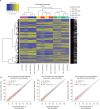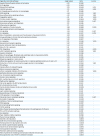1. Salak-Johnson JL, Webb SR. Pig social status and chronic cold or crowd stressors differentially impacted immune response. Open J Anim Sci. 2018; 8:280–293.

2. Pennarossa G, Maffei S, Rahman MM, Berruti G, Brevini TA, Gandolfi F. Characterization of the constitutive pig ovary heat shock chaperone machinery and its response to acute thermal stress or to seasonal variations. Biol Reprod. 2012; 87:119.
3. Ross J, Hale B, Gabler N, Rhoads R, Keating A, Baumgard L. Physiological consequences of heat stress in pigs. Anim Prod Sci. 2015; 55:1381–1390.

4. Baumgard LH, Rhoads RP Jr. Effects of heat stress on postabsorptive metabolism and energetics. Annu Rev Anim Biosci. 2013; 1:311–337.

5. Carroll JA, Burdick NC, Chase CC Jr, Coleman SW, Spiers DE. Influence of environmental temperature on the physiological, endocrine, and immune responses in livestock exposed to a provocative immune challenge. Domest Anim Endocrinol. 2012; 43:146–153.

6. Carroll JA, Matteri RL, Dyer CJ, Beausang LA, Zannelli ME. Impact of environmental temperature on response of neonatal pigs to an endotoxin challenge. Am J Vet Res. 2001; 62:561–566.

7. Lin YS, Lin MY, Leung TK, Liao CH, Huang TT, Huang HS, Pan HC. Properties and biological effects of high performance ceramic powder emitting far-infrared irradiation. Instrum Today. 2007; 6:60–66.
8. Yoo BH, Park CM, Oh TJ, Han SH, Kang HH, Chang IS. Investigation of jewelry powders radiating far-infrared rays and the biological effects on human skin. J Cosmet Sci. 2002; 53:175–184.
9. Leung TK, Lee CM, Lin MY, Ho YS, Chen CS, Wu CH, Lin YS. Far infrared ray irradiation induces intracellular generation of nitric oxide in breast cancer cells. J Med Biol Eng. 2009; 29:15–18.
10. Yu SY, Chiu JH, Yang SD, Hsu YC, Lui WY, Wu CW. Biological effect of far-infrared therapy on increasing skin microcirculation in rats. Photodermatol Photoimmunol Photomed. 2006; 22:78–86.

11. Inoué S, Kabaya M. Biological activities caused by far-infrared radiation. Int J Biometeorol. 1989; 33:145–150.

12. Leung TK, Lin SL, Yang TS, Yang JC, Lin YS. The influence of ceramic far-infrared ray (cFIR) irradiation on water hydrogen bonding and its related chemo-physical properties. Hydrology. 2014; 5:2.
13. Leung TK, Huang PJ, Chen YC, Lee CM. Physical‐chemical test platform for room temperature, far‐infrared ray emitting ceramic materials (cFIR). J Chin Chem Soc. 2011; 58:653–658.

14. Ishibashi J, Yamashita K, Ishikawa T, Hosokawa H, Sumida K, Nagayama M, Kitamura S. The effects inhibiting the proliferation of cancer cells by far-infrared radiation (FIR) are controlled by the basal expression level of heat shock protein (HSP) 70A. Med Oncol. 2008; 25:229–237.

15. Leung TK, Lin YS, Chen YC, Shang HF, Lee YH, Su CH, Liao HC, Chang TM. Immunomodulatory effects of far-infrared ray irradiation via increasing calmodulin and nitric oxide production in raw 264.7 macrophages. Biomed Eng (Singapore). 2009; 21:317–323.

16. Leung TK. In vitro and in vivo studies of the biological effects of bioceramic (a material of emitting high performance far-infrared ray) irradiation. Chin J Physiol. 2015; 58:147–155.
17. Gavish L, Perez LS, Reissman P, Gertz SD. Irradiation with 780 nm diode laser attenuates inflammatory cytokines but upregulates nitric oxide in lipopolysaccharide-stimulated macrophages: implications for the prevention of aneurysm progression. Lasers Surg Med. 2008; 40:371–378.

18. Smallwood HS, Shi L, Squier TC. Increases in calmodulin abundance and stabilization of activated inducible nitric oxide synthase mediate bacterial killing in RAW 264.7 macrophages. Biochemistry. 2006; 45:9717–9726.

19. Bogdan C. Nitric oxide and the immune response. Nat Immunol. 2001; 2:907–916.

20. Daff S. Calmodulin-dependent Regulation of Mammalian Nitric Oxide Synthase. London: Portland Press Limited;2003.
21. Weber TJ, Smallwood HS, Kathmann LE, Markillie LM, Squier TC, Thrall BD. Functional link between TNF biosynthesis and CaM-dependent activation of inducible nitric oxide synthase in RAW 264.7 macrophages. Am J Physiol Cell Physiol. 2006; 290:C1512–C1520.

22. Kim H, Moon C, Ahn M, Lee Y, Kim H, Kim S, Ha T, Jee Y, Shin T. Expression of nitric oxide synthase isoforms in the porcine ovary during follicular development. J Vet Sci. 2005; 6:97–101.

23. Cohen RI, Hassell AM, Ye X, Marzouk K, Liu SF. Lipopolysaccharide down-regulates inducible nitric oxide synthase expression in swine heart
in vivo
. Biochem Biophys Res Commun. 2003; 307:451–458.

24. Zelnickova P, Matiasovic J, Pavlova B, Kudlackova H, Kovaru F, Faldyna M. Quantitative nitric oxide production by rat, bovine and porcine macrophages. Nitric Oxide. 2008; 19:36–41.

25. Mathewson AM, McPhaden AR, Wadsworth RM. The induction and detection in vitro of iNOS in the porcine basilar artery. J Immunol Methods. 2003; 279:163–171.

26. Medzhitov R. Toll-like receptors and innate immunity. Nat Rev Immunol. 2001; 1:135–145.

27. Xia YF, Liu LP, Zhong CP, Geng JG. NF-kappaB activation for constitutive expression of VCAM-1 and ICAM-1 on B lymphocytes and plasma cells. Biochem Biophys Res Commun. 2001; 289:851–856.

28. Aktan F. iNOS-mediated nitric oxide production and its regulation. Life Sci. 2004; 75:639–653.

29. Lowenstein CJ, Padalko E. iNOS (NOS2) at a glance. J Cell Sci. 2004; 117:2865–2867.

30. Schröder NW, Opitz B, Lamping N, Michelsen KS, Zähringer U, Göbel UB, Schumann RR. Involvement of lipopolysaccharide binding protein, CD14, and Toll-like receptors in the initiation of innate immune responses by Treponema glycolipids. J Immunol. 2000; 165:2683–2693.

31. Rao KM. Molecular mechanisms regulating iNOS expression in various cell types. J Toxicol Environ Health B Crit Rev. 2000; 3:27–58.

32. Jungi TW, Adler H, Adler B, Thöny M, Krampe M, Peterhans E. Inducible nitric oxide synthase of macrophages. Present knowledge and evidence for species-specific regulation. Vet Immunol Immunopathol. 1996; 54:323–330.











 PDF
PDF Citation
Citation Print
Print



 XML Download
XML Download